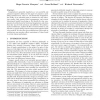Free Online Productivity Tools
i2Speak
i2Symbol
i2OCR
iTex2Img
iWeb2Print
iWeb2Shot
i2Type
iPdf2Split
iPdf2Merge
i2Bopomofo
i2Arabic
i2Style
i2Image
i2PDF
iLatex2Rtf
Sci2ools
AISB
2008
Springer
2008
Springer
A Modelling Framework for Functional Imagination
Imagination is generally regarded as a very powerful and advanced cognitive ability. In this paper we propose a modelling framework for what we call functional imagination: the ability of an embodied agent to simulate its own behaviors, predict their sensory-based consequences, and extract behavioural benefit from doing so. We identify five key components of architectures for functional imagination, and claim that they may be both necessary and sufficient. We outline a typical architecture, explain the flow of control within it, and describe a typical testing scenario using nested physics-based robot models. We also show how malfunctions within such an architecture may produce effects reminiscent of those found in certain human pathologies.
Advanced Cognitive Ability | AISB 2008 | Artificial Intelligence | Functional Imagination | Nested Physics-based Robot |
| Added | 12 Oct 2010 |
| Updated | 12 Oct 2010 |
| Type | Conference |
| Year | 2008 |
| Where | AISB |
| Authors | Hugo Gravato Marques, Owen Holland, Richard Newcombe |
Comments (0)

